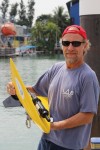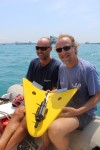Since its launch from Seville in April 2015, the 20,000 Sounds under the Seas program on ocean noise pollution, in partnership with the Laboratory of Bioacoustic Applications (LAB) of the Polytechnic University of Catalonia in Barcelona, continues its harvesting of underwater sounds, be they natural of produced by the human activity (shipping, sonars, oil and gas prospection among others).
In Singapore on 14 March 2018, during the press conference organized on the occasion of the stopover of Fleur de Passion in the City-State, the biologist and engineers Dr Michel André and responsible for the program insisted on the importance of this source of pollution of the oceans and the necessity to tackle this issue urgently.
« Marine noise pollution is recognized today as one of the greatest disrupters of marine ecosystems that threaten the natural balance of the oceans », recalls Dr Michel André and responsible for the 20,000 Sounds Under The Seas program.
« This pollution, little known to the general public because it is invisible and inaudible, at least for human ears, increases with the development of industrial activities at sea and spreads at high speeds in all the corners of the planet. Result: there is no more "end of the ocean" that is spared », explains the French scientist.
« Except maybe between French Polynesia and Australia, where levels of noise were measured in some deep-ocean areas were to be close to natural ambient noise levels, meaning that the contribution from human operations there is minimum and could be defined as the levels that were present in the ocean before its industrialisation. In other words close to pollution zero », he adds.
The situation is totally different in other regions of the globe as on the Great Barrier Reef for example. « Because most of the marine organisms found in coral reefs produce sounds, tracking these specific soundscapes represents one efficient way to monitor and understand possible changes », explains Dr André.
« The 20,000 Sounds Under the Seas program has collected sound recordings at sample stations and is currently comparing its analysis with the heath status of the coral reefs: it is expected that the acoustic monitoring of biodiversity will significantly contribute to understand the magnitude of the damage that this unique ecosystem is facing. »
« Now, that the expedition has entered more industrialized areas, we expect these levels to significantly increase along with the presence of heavy maritime traffic », he concludes.
The French scientist and the crew of Fleur de Passion took advantage of the stopover in Singapore to install on board and test a new recording equipment yet again specifically developed for the 20,000 Sounds Under The Seas program: a yellow delta shape wing some half a meter wide supporting the hydrophone device underneath, and that the boat will taw when navigating.
Using the dinghy as a trawler, a session of tests took place off Singapore in this unique environment made of hundreds of cargo or container ships, tankers and so on anchored of the island.
Some initial results of the program are accessible on http://omexpedition.listentothedeep.com/acoustics/.












